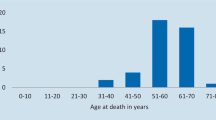Objectives. To assess published data and a series of clinical cases in relation to the clinical features of epilepsy, electroencephalographic changes, and other phenotypic features in X-linked intellectual disability (ID) caused by mutations in the KIAA2022 gene. Materials and methods. Retrospective analysis of medical records from various medical institutions of the Russian Federation was conducted, addressing disease and genealogical histories, , and clinical, genetic, electroencephalographic (EEG), and neuroimaging (brain MRI) investigations. The study included seven clinical cases (five girls and two boys, 5–13 years old) with confirmed diagnoses of X-linked ID due to mutations in KIAA2022 in whom the clinical picture of the underlying disease was combined with epilepsy. Results. The main general phenotypic characteristics of patients with X-linked ID due to KIAA2022 mutations were mental retardation, speech impairment, motor developmental delay, and dysmorphism. The most frequently encountered epileptic seizures were myoclonic and atonic, with nodding, propulsion, atypical absences, and EEG changes showing diffuse “spike– multispike–slow wave” complexes. No pathognomonic brain changes were found on MRI. Antiepileptic therapy was ineffective in many cases. Conclusions. The cases of X-linked ID combined with epilepsy described here indicate that this disease can occur both in males and females and that epilepsy is more often apparent as generalized seizures and in many cases is drug-resistant. More information is needed about this rare genetic syndrome.
Similar content being viewed by others
References
Gamirova, R. G., Gamirova, R. R., and Esin, R. G, “The genetics of epilepsy: progress, problems, and perspectives,” Zh. Nevrol. Psikhiatr., 120, No. 9, 144–150 (2020), https://doi.org/10.17116/jnevro2020120091144 (2020).
Webster, R., Cho, M., Retterer, K., et al., “De novo loss of function mutations in KIAA2022 are associated with epilepsy and neurode velopmental delay in females,” Clin. Genet., H. 91, No. 5, 756–763 (2016), https://doi.org/10.1111/cge.12854.
Stamberger, H., Hammer, T. B., Gardella, E., et al., “NEXMIF encephalopathy: an X-linked disorder with male and female phenotypic patterns,” Genet. Med., 23, No. 2, 363–373 (2020), https://doi.org/10.1038/s41436-020-00988-9.
De Lange, I. M., Helbig, K. L., Weckhuysen, S., et al., “De novo mutations of KIAA2022 in females cause intellectual disability and intractable epilepsy,” J. Med. Genet., 53, No. 12, 850–858 (2016), https://doi.org/10.1136/jmedgenet-2016-103909.
Van, M. L., Hou, Q., Kalscheuer, V. M., et al., “Loss of function of KIAA2022 causes mild to severe intellectual disability with an autism spectrum disorder and impairs neurite outgrowth,” Hum. Mol. Genet., 22, No. 16, 3306–3314 (2013), https://doi.org/10.1093/hmg/ddt187.
Gilbert, J. and Man, H., “The X-linked autism protein KIAA2022/KIDLIA regulates neurite outgrowth via N-cadherin and δ-catenin signaling,” eNeuro, 3, No. 5, ENEURO.0238-16.2016 (2016), https://doi.org/10.1523/ENEURO.0238-16.2016.
Charzewska, A., Rzońca, S., Janeczko, M., et al., “A duplication of the whole KIAA2022 gene validates the gene role in the pathogenesis of intellectual disability and autism,” Clin. Genet., 88, No. 3, 297–299 (2014), https://doi.org/10.1111/cge.12528.
Panda, P. K., Sharawat, I. K., Joshi, K., et al., “Clinical spectrum of KIAA2022/NEXMIF pathogenic variants in males and females: Report of three patients from Indian kindred with a review of published patients,” Brain Dev., 42, No. 9, 646–654 (2020), https://doi.org/10.1016/j.braindev.2020.06.005.
Lambert, N., Dauve, C., Ranza, E., et al., “Novel NEXMIF pathogenic variant in a boy with severe autistic features, intellectual disability, and epilepsy, and his mildly affected mother,” J. Hum. Genet., 63, No. 7, 847–850 (2018), https://doi.org/10.1038/s10038-018-0459-2.
Ogasawara, M., Nakagawa, E., Takeshita, E., et al., “Clonazepam as an effective treatment for epilepsy in a female patient with NEXMIF mutation: case report,” Mol. Syndromol., 11, No. 4, 232–238 (2020), https://doi.org/10.1159/000510172.
Wu, D., Ji, C., Chen, Z., et al., “Novel NEXMIF gene pathogenic variant in a female patient with refractory epilepsy and intellectual disability,” Am. J. Med. Genet. A, 182, No. 11, 2765–2772 (2020), https://doi.org/10.1002/ajmg.a.61848.
Fisher, R. S., Cross, J. H., French, J. A., et al., “Operational classification of seizure types by the International League Against Epilepsy: Position Paper of the ILAE Commission for Classification and Terminology,” Epilepsia, 58, No. 4, 522–530 (2017), https://doi.org/10.1111/epi.13670.
Lorenzo, M., Stolte-Dijkstra, I., van Rheenen, P., et al., “Clinical spectrum of KIAA2022 pathogenic variants in males: Case report of two boys with KIAA2022 pathogenic variants and review of the literature,” Am. J. Med. Genet. A, 176, No. 6, 1455–1462 (2018), https://doi.org/10.1002/ajmg.a.38667.
Author information
Authors and Affiliations
Corresponding author
Additional information
Translated from Zhurnal Nevrologii i Psikhiatrii imeni S. S. Korsakova, Vol. 122, No. 9, Iss. 2, pp. 14–20, September, 2022.
Rights and permissions
Springer Nature or its licensor (e.g. a society or other partner) holds exclusive rights to this article under a publishing agreement with the author(s) or other rightsholder(s); author self-archiving of the accepted manuscript version of this article is solely governed by the terms of such publishing agreement and applicable law.
About this article
Cite this article
Gamirova, R.G., Barkov, A.I., Shaimuchametova, V.A. et al. Epilepsy and Other Phenotypic Features of X-Linked Intellectual Disability Due to Mutations in the KIAA2022 Gene. Neurosci Behav Physi 53, 767–771 (2023). https://doi.org/10.1007/s11055-023-01467-9
Received:
Accepted:
Published:
Issue Date:
DOI: https://doi.org/10.1007/s11055-023-01467-9




